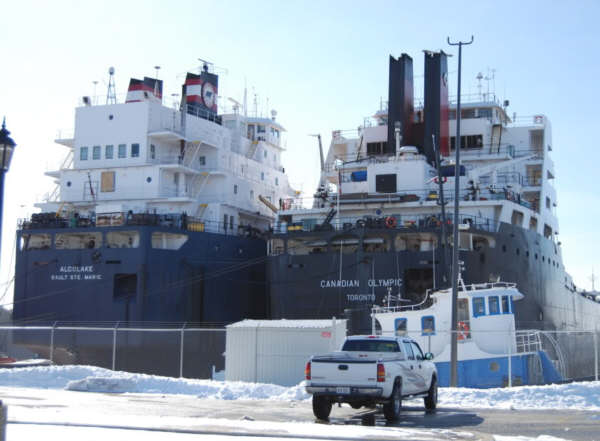
There was a day, up until about 33 years ago, that some Bay Cityans would be employed on ships being laid up for the winter. Winter Maintenance on Freighters Employs 1,200 at Great Lakes shipyards
|
||||||||||
| Printer Friendly Story View |
(EDITORIAL COMMENT: Maritime minded entrepreneurs and economic developers might take note of the following article, adapted from a report that also appeared in boatnerd.com.)
There was a day, up until about 33 years ago, that some Bay Cityans would be employed on ships being laid up for the winter.
But, alas, since the Defoe Shipbuilding Company closed in 1977, that sector of the job market is nonexistent here. However, elsewhere in the Great Lakes, the story is vastly different.
The Maritime Cabotage Task Force at Washington, D.C. reports that employment at Great Lakes shipyards has risen to about 1,200, driven by winter maintenance projects on freighters.
The 1,000-foot-long freighter Edwin H. Gott recently arrived at Bay Shipbuilding Company in Sturgeon Bay, Wis., launching the busiest time of year for Great Lakes shipyards.
This project and other annual winter maintenance work on U.S.-flag Great Lakes ships will provide jobs for more than 1,200 men and women at U.S. shipyards around the Great Lakes.
The Gott, one of the largest U.S.-flag vessels working the Great Lakes, is having new engines installed this winter that will increase its fuel efficiency and significantly reduce its air emissions.
The huge vessel, built in Sturgeon Bay in 1978, carries iron ore from the "Twin Ports" of Duluth, Minn./Superior, Wis., and Two Harbors, Minn., to Gary, Ind., Detroit, Mich., and Conneaut, Ohio, as well as Nanticoke in Ont., Canada.
A full load on a ship this size, 70,000 tons when water levels permit, will keep a major steel mill in operation for more than four days.
There are three large shipyards and several "top-side" repair facilities on the Great Lakes:
Bay Shipbuilding Company is located in Sturgeon Bay, Wis., and its winter workforce tops 750.
Donjon Shipbuilding and Repair in Erie, Pa., ups its workforce to more than 140 from December to April.
Employment at Fraser Shipyards, Inc, in Superior, Wis., grows to more than 200 during the winter. These three yards alone generate an annual payroll of nearly $50 million.
Smaller shipyards and repair facilities are located throughout the Great Lakes:
Toledo, Ohio, is home to H. Hansen Industries and IronHead Marine.
Cleveland, Ohio, hosts Cleveland Shiprepair Co. and Great Lakes Shipyard.
Basic Marine is based in Escanaba, Mich.
Other support services are available in Buffalo, Detroit, Chicago, Muskegon, Mich., Sault Ste. Marie, Mich., and Milwaukee.
The U.S.-flag Great Lakes fleet today involves approximately 70 large self-propelled vessels and integrated tug/barge units. These vessels have capacity of 120 million tons of dry- and liquid-bulk products. This enterprise generate more than 1,600 shipboard and shoreside jobs, depending on economic conditions.
Since vessels operate around the clock, more than 2,200 mariners are needed to keep the fleet sailing from late March until the official lakes shipping closing on January 15.
When these vessels arrive at their winter berths, they are often returning to the very place they were built. Under U.S. maritime law, the Jones Act to be specific, vessels that transport cargo between U.S. ports must be built in the United States, as well as owned by U.S. citizens and crewed with American mariners.


"Maintaining and modernizing American domestic vessels is a real economic driver in communities with shipyards and repair facilities," said Mark Ruge, counsel for Maritime Cabotage Task Force. "On the Great Lakes, it has been estimated that a wintering vessel generates at least $800,000 in economic benefits to the community."
Two other U.S.-flag lakers have been re-powered in recent years. In addition to the one re-powering scheduled for this winter, new generators will be installed on some vessels, and a mid-sized ship will have its steam turbine rebuilt.
Other projects for this coming winter include renewing steel in cargo holds and overhauling bow thrusters. Bow thrusters jet water in either direction and allow vessels to better maneuver in confined waters.
Unloading system conveyor belts will be replaced on several vessels. Virtually every U.S.-flag laker is capable of discharging cargo without any assistance from shoreside personnel or equipment. The cost savings are but one benefit. With self-unloading vessels, virtually any waterfront property can become a working dock.
Most of these projects will not be performed in drydock. However, a number of U.S.-flag lakers will be placed in drydock so the U.S. Coast Guard can sound the hull during an internal and external stem-to-stern inspection of the vessel.
When the U.S.-flag Lakes fleet returns to service next spring, a new vessel will continue to take shape at the Donjon yard in Erie, Pa. The yard is building a 740-foot-long self-unloading barge that will be coupled with a tug also under construction there. As construction of the barge ramps up to full speed, employment at the yard will reach 200.
Raw materials dominate the Jones Act trades on the Great Lakes. Iron ore for the steel industry can top 50 million tons. Coal for power generation can total more than 27 million tons. Limestone cargos for the construction and steel industries can approach 30 million tons. Other cargos include cement for the construction industry, salt to de-ice wintry roads, industrial sand, asphalt, and light fuel and heating oils. ###
| Printer Friendly Story View |
|
|

Dave Rogers |
|
|
|
Printer-Friendly Story View
0200 Nd: 04-21-2024 d 4 cpr 0
12/31/2020 P3v3-0200-Ad.cfm
SPONSORED LINKS
12/31/2020 drop ads P3v3-0200-Ad.cfm


